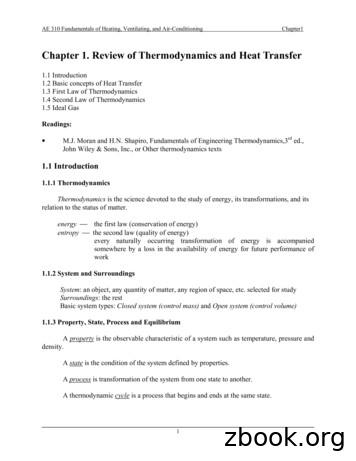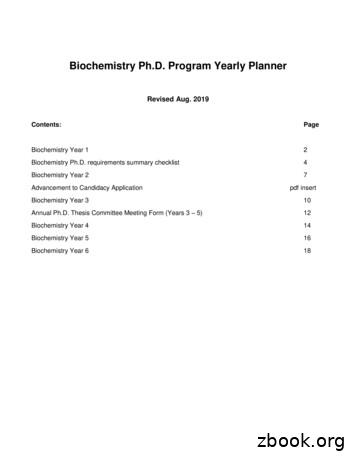1.#Biochemistry,#and# Thermodynamics#
8/24/15BIOCH 755: Biochemistry IFall en#Office#Hour:#M#1:30 e:#785 2518#Overall#Course#Setup# Time%&%Loca on:%MWF#12:30 1:20#pm,#Burt#114#%Instructors:%#– Sec on%I:#Jianhan#Chen,#034#Chalmers,#532 2518,#jianhac@ksu.edu– Sec on%II:#Larry#Davis,#062#Chalmers,#532 6124,#ldavis@ksu.edu#– Sec on%III:#Gerald#Reek,#203#Burt,#532 6117,#reeck@ksu.edu## and#plan#accordingly#– Sec on#I:#Sep#28#(M)#during#the#class# me#– Sec on#II:#Nov#2#(M)#during#the#class# me#– Sec on#III:##Dec#16#(Wed)#4:10 6:00#PM#(In#the#finals#week)# Grading:#100#points#each#sec on;#the#final#leUer#grades#for#the#en es#from#all#three#sec ons#and#grading#on#a#curve.##(c)#Jianhan#Chen#2#1
8/24/15Sec on#I#Overview# ��#Sept#28#(M)#Mostly#cover#Chapters#1 2,#4 KSOL##– Be#prepared#to#take#good#notes#during#lectures# Office#hours:#M#1:30#–#2:30#PM,#Chalmers#034#– Or#by#appointment# pt#28#(Monday)#No#make han#Chen#3#(c)#Jianhan#Chen#4#2
8/24/15Which of the following fields isbiochemistry NOT relevant to?A.B.C.D.E.ImmunologyNutritionKinesiologyWaste managementBrewingWhich of the following elements is mostabundant (in % weight) in the human body?A.B.C.D.E.HONCBoth H and C are equally abundant3
8/24/15To what class does the followingcompound belong?A.B.C.D.LipidCarbohydrateAmino acidNucleotideWhich#of#the#following#func .B.C.D.aminocarboxylhydroxylaldehyde4
8/24/15To what class of moleculedoes the following belong?A.B.C.D.CarbohydrateLipidAmino acidNucleotideBIOCH 755: Biochemistry IFall en#Office#Hour:#M#1:30 e:#785 2518#5
8/24/15Biochemistry# Chemistry#of#life#– les#– Interac on#of#biomolecules#– Synthesis#and#degrada on#of#biomolecules#(metabolism)#– Energy#genera on#and#consump on#– Regula on#of#biomolecules#– Gene c#informa on#storage,#transla on,#and#propaga on# Highly#interdisciplinary# Direct#implica Introduc on#to#the#Chemistry#of#Life# Key%Concepts%1.1:%%– d#number#of#elements.#– Certain#func ypes#of####biomolecules.#– During#chemical#evolu x#molecules#and#polymers.#– Self replica lec on.#(c)#Jianhan#Chen#12#6
8/24/15Human#Body#Mass#Composi nhan#Chen#14#7
n#Chen#15#Biological#Polymers# ough#condensa on#reac ons#of#various#monomers# Two#extremely#important#outcomes:#– Exponen ally#increase#in#the#chemical#versa lity#(NM)#– Possibility#of#replica on#(informa on#storage,#propaga on#&#evolu on)!#(c)#Jianhan#Chen#16#8
8/24/15Condensa on#and#Hydrolysis#(c)#Jianhan#Chen#17#Replica on:#Muta on#&#Evolu on#(c)#Jianhan#Chen#18#9
e Obeys Thermodynamics10
8/24/151.3.#Thermodynamics# nthalpy#and#the#change#in#entropy#(ΔG# #for#a#reac concentra s#(ΔG# e#condi ons#as#a#temperature#of#25 avorable#reac # Only#changes#can#be#measured#ΔE q wdE δq - δw If#only#P#dV#work#(expansion#or#contrac on)#done:# dE δq - PdV δqif constant VΔE qv – change!#(c)#Jianhan#Chen#22#11
8/24/15First#Law#of#Thermodynamics# Conserva ergy#(E)#ΔE q wdE δq - δw Internal#energy#(E)# – State#Func ath#of#arrival#– Microscopically:#mul ple#contribu ons#including:#kine c,#vibra onal,#rota onal,#(chemical)#bonding,#non bonded#interac ochemistry)#components#– Macroscopically:#only#definable#on#rela about#heat#measured#in#more# natural #setngs#with#constant#pressure?### s#with#PV#work#exchange#with#environment:##dE δq - PdV– hange!## Need#to#introduce#the#concept#of#enthalpy:#H# #E# #PV#– ut#other#types#of# work#done)#is#the#enthalpy#change!## Biochemical#reac ons#in#solu on#(NPT#condi on)#– Volume#change#is#minimal#(ΔV# #0)#– dH# #dE# #PΔV# #dE#– ternal#energy##(c)#Jianhan#Chen#24#12
8/24/15Energy#dictates#the#direc on#of#many#processes# ##but#not#always#ΔE #the#direc #of#Thermodynamics# n#an#irreversible#process## #higher#temperature #(Rudolf#Clausius)#– #the#absorp rsion#into#work .#(Lord#Kevin #– #– Existence#of#absolute#zero#temperature#(T# #0#K)# Third#law#of#thermodynamics:#S# #0#at#T# #0#for#perfect#crystals.#(c)#Jianhan#Chen#26#13
8/24/15Entropy# lability#of#a#system s#energy#to#do#work#(S qrev/T).# n#the#context#of#sta s cal#mechanics#– A#sta s tate#(lex#equa on)#– A#measure#of#uncertainty#(from#informa on#theory)#(right#equa on)#S k B pi ln piS kB ln WikB: Boltzmann’s constantW: number of microscopic statepi: probability of a microscope state esses# Both#enthalpy#and#entropy#maUer#(normal/NPT#condi on)# Gibbs#free#energy:#ΔG# #ΔH#–#T#ΔS# )#Jianhan#Chen#28#14
8/24/15Enthalpy#and#Entropy#Compensa on#Enthalpy ΔG# #ΔH#–#TΔS# ativeΔHf# #0###ΔSf# #0#1. Low#temperature,#ΔGf# #ΔHf#–#TΔSf# #0#(folding)#(the#favored#state#is#not#the#more# random #denatured#state!)##2. At#folding#temperature#Tm,#ΔGf# #0#(pf# #pu# #0.5)#3. High#temperature,#ΔGf# #ΔHf#–#TΔSf# nstant# Remember#that#given#a#reac on:### # # # # # #A# #B# #C# #D##the#quan ty:#K# rred#to#as#an# equilibrium#constant .#But#why#a#constant?## Proof:##First,#needs#to#define#a# standard#state #(commonly#298K,#1atm,#1M).#Then#for#a#solu on#with#a#concentra on#[A],#####G# #G0# #RT#ln#([A]/[A]0)# #G0# #RT#ln#[A]# Therefore,ΔG# #ΔG0# #RT#ln#([C][D]/[A][B])# At#equilibrium,#ΔG# #0.#Thus,#####ΔG0# #RT#ln#([C][D]/[A][B])# #0#####ΔG0# # #RT#ln#K#####K# ##[C][D]/[A][B]# #exp#(# #ΔG0/RT)##(c)#Jianhan#Chen#30### 15
8/24/15Thermochemistry# Experimental#determina H#and#ΔS.## ΔG#can#be#directly#calculated#from#Keq#– Oxen#done#by#fitng#to#a# tra on#curve#– ding#or#(bio )chemical#reac on# Determina on#of#ΔH#and#ΔS#– Van t#Hoff#Rela onship#– Calorimetry#– Theory#and#simula on:#not#reliable#at#quan ta ve#level#(c)#Jianhan#Chen#31#Van t#Hoff#Rela onship# The#classical#approach,#require#mul #and#certain#assump ons#lnK eq ΔG 0ΔH 0 ΔS 0 RTRTR Assuming#that#ΔH#and#ΔS#are#temperature# independent#(oxen#a#strong#assump on#in#biochemical/biophysical#processes# # safer #to#calculate#ΔS (ΔH ΔG)/R#(c)#Jianhan#Chen#32#16
8/24/15Biosphere:Energy Flow in an Open SystemSummary# ymers,Key,concepts,of,thermodynamics, Coming,up:,water,and,what,is,special,about,it,3417
8/24/15Which of the following is not true forbiochemical standard conditions?A. The concentrations of reactants and productsis 1M.B. The concentration of hydrogen ions is 1M.C. Temperature is 25oC/298K.D. Pressure is 1 atmosphere.18
ochemistry”,#4th#Ed.,# 65:#Biochemistry#II#in# Spring#2016).# rdingly# – Sec on#I:#Sep#28#(M)#during#th
1.4 Second Law of Thermodynamics 1.5 Ideal Gas Readings: M.J. Moran and H.N. Shapiro, Fundamentals of Engineering Thermodynamics,3rd ed., John Wiley & Sons, Inc., or Other thermodynamics texts 1.1 Introduction 1.1.1 Thermodynamics Thermodynamics is the science devoted to the study of energy, its transformations, and its
4. Plant Biochemistry 5. Clinical Biochemistry 6. Biomembranes & Cell Signaling 7. Bioenergetics 8. Research Planning & Report Writing (Eng-IV) 9. Nutritional Biochemistry 10. Bioinformatics 11. Industrial Biochemistry 12. Biotechnology 13. Immunology 14. Current Trends in Biochemistry
1. Fundamentals of Biochemistry by J.L. Jain 2. Biotechnology by B.D., Singh 3. Principles of Biochemistry by Lehninger, Nelson & Cox 4. Outlines of Biochemistry by Conn & Stumpf 5. Textbook of biochemistry by A VSS, Ramarao 6. An Introduction to Practical Biochemistry by D.T. Plummer 7. Laboratory Manual in Biochemistry by Jairaman
Reversible and Irreversible processes First law of Thermodynamics Second law of Thermodynamics Entropy Thermodynamic Potential Third Law of Thermodynamics Phase diagram 84/120 Equivalent second law of thermodynamics W Q 1 1 for any heat engine. Heat cannot completely be converted to mechanical work. Second Law can be formulated as: (A .
Analytical Biochemistry (Textbook) Analytical Biochemistry, 2nd edition, by D.J. Holme and H. Peck, Longman, 1993 Available on Reserve. Physical Biochemistry (Textbook) Physical Biochemistry (2nd edition, 1982) D. Freifelder (QH 345.F72). This is a particularly good reference text for spectroscopy, centrifugation, electrophoresis, and other .
Department of Biochemistry Introduction: The dynamic department of Biochemistry is spear headed by our worthy principal Lt Gen Abdul Khaliq Naveed (HI) who is a pioneer in the field of medical biochemistry, chemical pathology and medical genetics. He is presiding over the national Society of Medical Biochemistry (SOMB).
Advancement to Candidacy Application pdf insert Biochemistry Year 3 10 Annual Ph.D. Thesis Committee Meeting Form (Years 3 – 5) 12 Biochemistry Year 4 14 Biochemistry Year 5 16 Biochemistry Year 6 18
Department of Biochemistry - Website information 1. Department: Biochemistry 2. About Department The Department of Biochemistry was instituted as one of the departments of Sciences in the academic year 1998-1999. 3. Objective & Scope To enable the students to understand the concept of biochemistry regarding biomolecules























